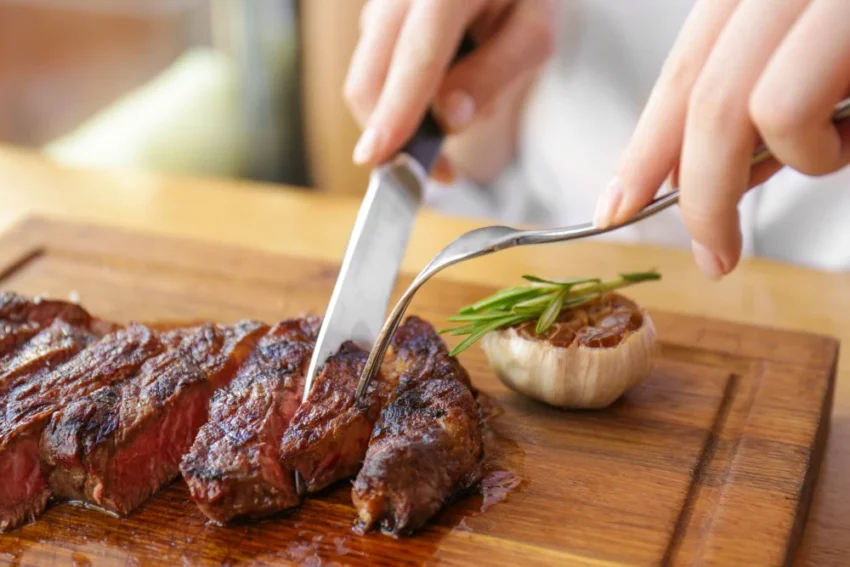Selecting the right steak knives for your restaurant is crucial to ensure an exceptional dining experience for your guests. The right steak knives not only enhance the presentation of your meals but also improve the ease and enjoyment of eating a perfectly cooked steak.
This guide will help you choose the ideal steak knives for your restaurant by considering factors such as blade material, handle design, aesthetics, and maintenance.
Understanding Blade Materials
Stainless Steel
Stainless steel is a popular choice for steak knife blades due to its durability and resistance to rust and corrosion. High-quality stainless steel knives maintain their sharpness for extended periods, which is essential for restaurant use. Opt for high-carbon stainless steel for better edge retention and sharpness, ensuring a smooth cut with every use.
Carbon Steel
Carbon steel blades offer exceptional sharpness and edge retention, making them a top choice for professional kitchens. However, they require more maintenance to prevent rust and discoloration. If you choose carbon steel knives, be prepared for regular cleaning and oiling to keep them in pristine condition.
Ceramic
Ceramic blades are incredibly sharp and lightweight, offering a unique alternative to traditional metal knives. They are rust-resistant but can be brittle and prone to chipping. Ceramic knives are ideal for establishments that prioritize sharpness and a modern aesthetic, provided they are handled with care.
Handle Design and Comfort
Ergonomic Handles
Ergonomic handle design is essential for comfort, especially in a restaurant setting where knives are used frequently. Look for handles that fit comfortably in the hand and provide a secure grip. Materials such as wood, plastic, and stainless steel are common, each offering different benefits. Choose a material that complements your restaurant’s style and feels good in hand.
Full Tang vs. Partial Tang
Full tang knives, where the blade extends the entire length of the handle, offer superior balance and durability. This design is preferable for heavy use in restaurants. Partial tang knives are lighter but may not withstand the rigors of a busy kitchen as well as full tang knives. For a professional setting, full tang construction is generally recommended.
Types of Steak Knives
Straight Edge
Straight edge steak knives have a smooth, non-serrated blade, providing clean cuts through meat. They require regular sharpening but offer precision slicing, ideal for high-end restaurants where presentation and texture are paramount.
Serrated Edge
Serrated edge steak knives feature a saw-like blade that easily cuts through tougher cuts of meat. They require less frequent sharpening, making them practical for high-traffic restaurants. However, serrated knives can tear meat fibers, which might not be ideal for every dish.
Hollow Edge
Hollow edge steak knives have small indentations along the blade, reducing friction and preventing food from sticking. This design allows for smooth and effortless slicing, enhancing the dining experience for your guests.
Aesthetics and Presentation
Matching Your Restaurant’s Theme
The design and appearance of your steak knives should complement your restaurant’s theme and ambiance. Whether you prefer a classic, rustic look with wooden handles or a modern, sleek design with stainless steel, choose knives that enhance your overall table setting.
Consistency and Brand Image
Consistent, high-quality steak knives contribute to a cohesive brand image. Ensure that all knives used in your restaurant are of the same style and quality to maintain a professional and uniform appearance. Investing in branded knives with your restaurant’s logo can also add a touch of sophistication.
Maintenance and Care
Cleaning
Proper cleaning is vital for maintaining the longevity and performance of your steak knives. Hand wash the knives with warm, soapy water and dry them immediately to prevent rust and corrosion. Avoid using a dishwasher, as the high heat and harsh detergents can damage the blades and handles.
Sharpening
Regular sharpening is essential for keeping your steak knives in top condition. Use a sharpening stone, honing rod, or professional sharpening service to maintain the edge. Serrated knives require special sharpeners designed for their unique blade.
Storage
Store your steak knives in a knife block, magnetic strip, or protective sheath to prevent damage and ensure safety. Proper storage also helps maintain the sharpness of the blades and keeps them easily accessible for your staff.
Conclusion
Choosing the right steak knives for your restaurant involves careful consideration of blade material, handle design, aesthetics, and maintenance. By investing in high-quality steak knives, you ensure a superior dining experience for your guests and reinforce your restaurant’s commitment to excellence. The right steak knives not only enhance the enjoyment of a perfectly cooked steak but also contribute to the overall ambiance and professionalism of your establishment.

